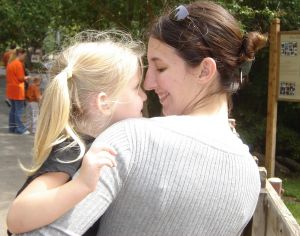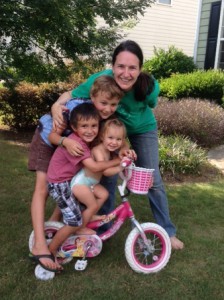Editor’s note: This post was originally published on Oct. 14, 2008, but so many parents through the years since and in the future can relate well to its message.
 Nighttime has confronted us with some of the most challenging parenting moments we’ve faced so far, but being present for our now 14-month-old daughter at 3:00 in the morning is just as important as it is at any more reasonable hour.
Nighttime has confronted us with some of the most challenging parenting moments we’ve faced so far, but being present for our now 14-month-old daughter at 3:00 in the morning is just as important as it is at any more reasonable hour.
Though it isn’t always as easy, or as pleasant, as engaging her in a silly song, or reading Counting Kisses again, she doesn’t stop needing us when the sun goes down.
Our nighttime parenting has evolved in response to our daughter’s needs — and our fumbling attempts to meet them.
The day she was born, she never left our arms until after midnight, when we laid her carefully in the plastic bassinet the hospital provided before turning in ourselves. As we gazed down at our brand-new baby girl, she spit up a little — and we froze at the terrifying idea that she could choke while we slept.
Without further ado, I scooped her up and climbed into the bed, where she slept in my arms, nursing on and off the rest of the night.
When we brought her home the next day, we carefully attached an Arm’s Reach Cosleeper to our bed, eager for her to sleep close to us. We were aware of the benefits of sleeping in close proximity from reading Dr. Sears’ resources — including decreased risk of SIDS (Sudden Infant Death Syndrome) — and the Cosleeper made us feel more comfortable about sleeping next to a newborn.
But the first time we lowered our sleeping infant onto its thin mattress, she awoke immediately, howling in protest. We tried again, gently easing her from our bodies to this space where we had intended for her to sleep, but she made it clear she had other ideas.
And so the Cosleeper was relegated to serving as a makeshift nightstand, until its eventual relocation to the storage units Boise, and we began the process of trying to determine how to help our baby sleep.
As a newborn, she slept best semi-upright on our chests. When she was 5 weeks old, we discovered she was suffering from reflux, which explained her profound discomfort at lying flat on her back. But even after she outgrew the reflux at about 4 months, we still couldn’t seem to coax her to sleep for any significant length of time.
We made sure she wore comfortable PJs, was clean and dry, and had a belly full of breastmilk before bedtime each night. We tried putting her down in her crib and in her swing, with white noise and without, swaddled and unswaddled, on her back and on her side, with the nightlight on and off. And each time, about an hour after she succumbed to sleep, she’d wake and we would go try again.
We also tried cosleeping, hopeful that being close to us would provide her some comfort, but found that such proximity only stimulated her to fight sleep in order to nurse frantically all night. I awoke more than once to a find a puddle of my milk pooled under her head. So we’d try variations of other arrangements again, which would allow her to sleep more peacefully, if not for long.
We didn’t expect her to sleep through the night at 6 weeks, or even 6 months, understanding that night-waking is normal. We were more than willing to attend to her in the wee hours, and I was happy to nurse her more than once overnight.
But months of hourly — and occasionally more frequent — waking was wearing us down. Frustrated and exhausted, we stumbled through our days and nights, and desperately searched books on baby sleep for a solution. The mainstream consensus was clear: Our baby should be sleeping through the night by now, and if she wasn’t, we should “help” her by leaving her to cry it out.
We considered that advice but quickly concluded that cry-it-out methods weren’t compatible with the Attachment Parenting approach in which we believed.
Editor’s note: Parents, especially first-timers who are overwhelmed by the conflicting advice of well-meaning family members, doctors and popular parenting sources, need research-based safety information to help them make decisions for their family. Attachment Parenting International (API), in consultation with many experts in the area of infant sleep, has this information in the form of an Infant Sleep Safety Guidelines brochure and wants to get it into the hands of parents everywhere to ensure that all babies can be safe during sleep, at night and at naptime, regardless of whether you share sleep in the same bed, use a cosleeping bassinet, or use a crib.
At some point, we accepted that there probably wasn’t a silver bullet for our sleep struggles. The answer to the question of what to do for our daughter, a restless sleeper with high nocturnal needs, was simple and one we’d known all along: When she cried, we would respond. Every time.
Sometimes I nursed her as soon as she stirred. Sometimes her Dada snuggled with her or patted her bum softly until she drifted back into slumber. We continued to bring her into our bed, and finally, one night when she was almost 11 months old, she finished nursing, rolled over and went to sleep. It was the first night she’d actually slept next to me without nursing for a few hours, and she hasn’t been back in her crib since.
Cosleeping feels right for us.
Though she still stirs often throughout the night, just being beside us seems to lengthen each stretch of snooze. Finally we can comfort her without waking ourselves! And when she does arouse, if she isn’t easily soothed back to sleep, she nestles next to me and nurses, and we doze off together again.
Of course there are nights when we find ourselves exasperated at the fact that we haven’t enjoyed a night of unbroken sleep for over a year, but we are committed to giving her our presence even when it isn’t easy to do so. And when the sun comes up on her sweet face between my husband and me, I wouldn’t want any of us to be anywhere else.
Disclaimer: API urges parents to use good sense regarding the safety of their children. API publishes this information knowing that parents are engaged in the use of cribs and cosleeping in all its forms, and as such, API is committed to keeping children safe and healthy by providing the most current safety information available. API, its Support Groups, its sponsors and its partners assume no liability in the event of infant, child or parent harm and are held harmless from any harm, loss or legal arising from information they provide.
 For the last few days, my son has been hunched over an application for a summer program at NASA. I’ve been helping him, shoulder to shoulder, when he needs it, and I find myself staring at him when he’s not looking. It’s his junior year, and he’ll soon be filling out college applications.
For the last few days, my son has been hunched over an application for a summer program at NASA. I’ve been helping him, shoulder to shoulder, when he needs it, and I find myself staring at him when he’s not looking. It’s his junior year, and he’ll soon be filling out college applications.






